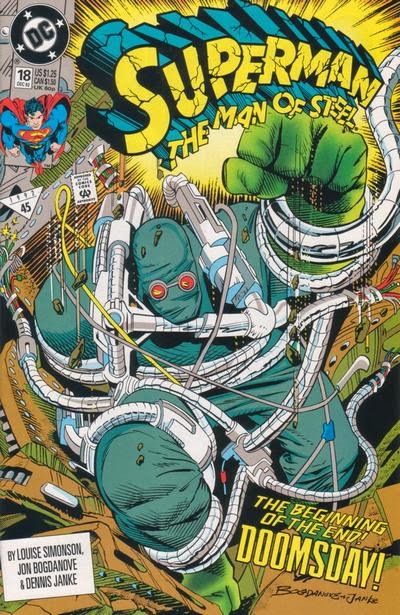Doomsday! Part One
Credits: Louise Simonson (writer), Jon Bogdanove (penciler), Dennis Janke (inker), Bill Oakley (letterer), Glenn Whitmore (colorist)
Summary: An orphan named Keith spies on the Underworlders that claim to have kidnapped his mother. He soon discerns that they lied to him, so Keith attracts Superman’s attention with a giant “S” emblem spray-painted on a basketball court. Superman listens to Keith and travels to Underworld, where Lois is already in danger, investigating the Underworlders’ plans to attack the surface. Superman defeats the mutated Underworlders and discovers that Lois is safe, thanks to a homeless man named Charlie that knows Lois from the shelter where she volunteers. Meanwhile, Doomsday escapes from a metal prison and begins to cause havoc.
Irrelevant Continuity: Doomsday doesn’t have a name yet, but I’m going to be calling him that for simplicity’s sake. At this point, he’s still covered in a green jumpsuit, with one hand tied with cables behind his back.
Mom, Apple Pie, etc…: Superman comforts the frantic Keith with a big hug.
I Love the ‘90s: Lois leaves a typed note on Clark Kent’s computer before going out. When Clark sees it, he remarks that it’s “very high tech of her.”
Total N00B:
- The story of Keith and the Underworlders is obviously continued from previous issues. I have no idea who the Underworlders are, but I’m assuming they’re DC’s version of the Morlocks. Apparently, there’s a faction of pro-war and anti-war Underworlders, with the normal humans seemingly in the anti-war camp.
- After Superman leaves, Charlie wonders if they should’ve told him about “Bloodthirst.” His friend replies “Bloodthirst is our problem!” Well, that’s settled.
- Superman believes the “War World escapees” are behind the Underworlders’ advanced weaponry. I only associate “War World” with the worst two episodes of the Justice League cartoon, although I’m assuming the comics’ version has a similar backstory.
Review: Man of Steel #18 is the first full appearance of Doomsday, even though his debut has been teased with several pages of him punching through his prison door during the previous few weeks of Superman comics. For anyone unaware, the Superman titles ran as a weekly comic during this period, with each creative team picking up where the other left off the previous week. I can’t imagine this was a creatively satisfying environment, but it seems as if the writers and artists involved didn’t mind so much. During annual retreats, the plan for the next year was plotted ahead, with everyone pitching in ideas. I’m guessing the creators enjoyed the collaborative process, because virtually every Superman book during this era has a strong creative team. It’s hard to imagine DC or Marvel pulling this off today without someone quitting after the first week and giving a blistering indictment of the company on Twitter, but the creators of this era seemed pretty content with the arrangement.
As famously documented, the big story for 1992 was supposed to be the wedding of Clark Kent and Lois Lane. The upcoming Lois and Clark TV show derailed those plans, so the creators were left with a year’s worth of stories to fill. Jerry Ordway’s sarcastic suggestion to just kill Superman, a joke he apparently did every year, suddenly began to be taken seriously. Dan Jurgens suggested a raging behemoth, a force of nature, be the villain responsible for Superman’s death, in contrast to Superman’s tradition of facing evil scientists and crooks in business suits. Doomsday, as he appears in this issue, is cloaked in mystery; his goggles, random metallic cables, and green jumpsuit suggest a sci-fi origin, but none is given in the immediate future. After weeks of teasing, punching at a metal wall (the sound effect “DOOM” surprisingly not used until he finally breaks free this issue), Doomsday escapes while Superman is having fun with the faux-Morlocks. (Or did the Underworlders come first?) His first act is to take a tiny bird in his hand, contemplate it, then crush it while laughing manically.
I don’t think there’s any denying that Doomsday is a walking plot device, but his introduction this issue works fairly well. I feel the early, cloaked design of Doomsday is a great visual; he’s some form of monster, but your mind is free to fill in the gaps. As the story progresses, we eventually discover Doomsday is gray Hulk with odd bone growths, sporting green bicycle shorts for some unfathomable reason. This design I’ve always considered kind of a joke, although the Justice League cartoon would later produce a Kirby-esque remake of this look that had a certain charm to it. Since I like the original “bagged” Doomsday look the best, this might turn out to be my favorite chapter of the initial storyline. I doubt today that Simonson would’ve been allowed to finish off a rather tame storyline while giving Doomsday his full debut in the same issue, but the discrepancy works to the story’s advantage. I like the sense that something horrible is approaching, while Superman’s still going about a seemingly average adventure. I don’t think it would’ve hurt DC to reprint the issue or two leading up to this story in the Death of Superman trade, however. It’s not as if the extra material would’ve broken the bank, especially on a book guaranteed to sell out, and those additional pages would’ve helped the narrative flow of the Underworld story immensely.











